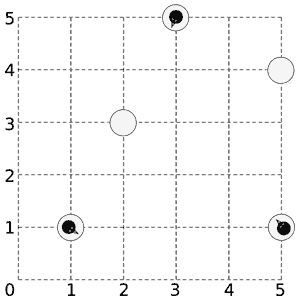POJ 3498 最大流
来源:互联网 发布:最简单的游戏c编程 编辑:程序博客网 时间:2024/05/16 14:59
Description
Somewhere near the south pole, a number of penguins are standing on a number of ice floes. Being social animals, the penguins would like to get together, all on the same floe. The penguins do not want to get wet, so they have use their limited jump distance to get together by jumping from piece to piece. However, temperatures have been high lately, and the floes are showing cracks, and they get damaged further by the force needed to jump to another floe. Fortunately the penguins are real experts on cracking ice floes, and know exactly how many times a penguin can jump off each floe before it disintegrates and disappears. Landing on an ice floe does not damage it. You have to help the penguins find all floes where they can meet.

A sample layout of ice floes with 3 penguins on them.
Input
On the first line one positive number: the number of testcases, at most 100. After that per testcase:
One line with the integer N (1 ≤ N ≤ 100) and a floating-point number D (0 ≤ D ≤
100 000 ), denoting the number of ice pieces and the maximum distance a penguin can jump.N lines, each line containing xi, yi, ni and mi, denoting for each ice piece its X and Y coordinate, the number of penguins on it and the maximum number of times a penguin can jump off this piece before it disappears (
−10 000 ≤ xi, yi ≤10 000 , 0 ≤ ni ≤ 10, 1 ≤ mi ≤ 200).
Output
Per testcase:
- One line containing a space-separated list of 0-based indices of the pieces on which all penguins can meet. If no such piece exists, output a line with the single number −1.
Sample Input
25 3.51 1 1 12 3 0 13 5 1 15 1 1 15 4 0 13 1.1-1 0 5 100 0 3 92 0 1 1
Sample Output
1 2 4-1
题意:一些企鹅站在浮冰上,想要见到别的企鹅。企鹅不想变湿,所以他们直接从一个浮冰跳到另一个浮冰。
每个浮冰有一个跳跃次数上限,可供企鹅从当前浮冰跳到别的浮冰。
问有哪些浮冰可以让所有企鹅在这碰面,输出浮冰的序号(序号下标从0开始)。如果不存在这样的浮冰,输出-1。
题解:把一个点i拆成ai和bi,ai代表这个点的入口,bi代表出口,那么ai流向bi的流量只能是这块浮冰最大的跳跃数。
然后暴力寻找当前浮冰能跳到哪上面,bi跳到它的aj上,因为ai限制了bi,所以bi到aj的流量可以是无穷。
定义起点为0,那么0需要与每个i连边,流量是第i块浮冰的企鹅数。
对于判断每块浮冰是否符合条件,只要在ai处加一条流往另一个点无穷的流量作为终点,判断0到这个点的最大流量是否等于sum即可。
#include<cstdio> #include<cstring> #include<queue> #include<cmath> #include<vector>using namespace std; const int Ni = 310; const int MAX = 1<<26; struct Edge{ int u,v,c; int next; }edge[2000*Ni]; int n,m; int edn;//边数 int p[Ni];//父亲 int d[Ni]; int sp,tp;//原点,汇点vector<int>spp; struct node{double x,y;int num,dis;}e[305];void addedge(int u,int v,int c) { edge[edn].u=u; edge[edn].v=v; edge[edn].c=c; edge[edn].next=p[u]; p[u]=edn++; edge[edn].u=v; edge[edn].v=u; edge[edn].c=0; edge[edn].next=p[v]; p[v]=edn++; } int bfs() { queue <int> q; memset(d,-1,sizeof(d)); d[sp]=0; q.push(sp); while(!q.empty()) { int cur=q.front(); q.pop(); for(int i=p[cur];i!=-1;i=edge[i].next) { int u=edge[i].v; if(d[u]==-1 && edge[i].c>0) { d[u]=d[cur]+1; q.push(u); } } } return d[tp] != -1; } int dfs(int a,int b) { int r=0; if(a==tp)return b; for(int i=p[a];i!=-1 && r<b;i=edge[i].next) { int u=edge[i].v; if(edge[i].c>0 && d[u]==d[a]+1) { int x=min(edge[i].c,b-r); x=dfs(u,x); r+=x; edge[i].c-=x; edge[i^1].c+=x; } } if(!r)d[a]=-2; return r; } int dinic(int sp,int tp) { int total=0,t; while(bfs()) { while(t=dfs(sp,MAX)) total+=t; } return total; } int main() { int i,u,v,c,t,j,k;double D;scanf("%d",&t); while(t--) { int sum=0; scanf("%d%lf",&n,&D); for(i=1;i<=n;i++){ scanf("%lf%lf%d%d",&e[i].x,&e[i].y,&e[i].num,&e[i].dis); sum+=e[i].num; } spp.clear(); sp=0; for(i=1;i<=n;i++){memset(p,-1,sizeof(p)); edn=0;//初始化 for(k=1;k<=n;k++){ for(j=k+1;j<=n;j++){ if((e[k].x-e[j].x)*(e[k].x-e[j].x)+(e[k].y-e[j].y)*(e[k].y-e[j].y)<D*D){ addedge(k+100,j,2005); addedge(j+100,k,2005); } } addedge(k,k+100,e[k].dis); addedge(0,k,e[k].num); } tp=i+200; addedge(i,i+200,2005); int ans=dinic(sp,tp); if(ans==sum){ spp.push_back(i-1); } } if(spp.empty())printf("-1\n"); else{ for(i=0;i<spp.size();i++){ if(i)printf(" %d",spp[i]); else printf("%d",spp[i]); } printf("\n"); } } return 0; } - POJ 3498 最大流
- POJ 3498 拆点 最大流
- poj 3498 (最大流,枚举汇点)
- poj 3498(最大流+拆点)
- poj 1698(最大流)
- poj 1459(最大流)
- poj 1087(最大流)
- poj 1087 最大流
- POJ 3436 最大流
- POJ 1273 最大流
- POJ 3204 最大流
- poj 1698 最大流
- POJ 3084 最大流
- POJ 1149 最大流
- poj 1698 最大流
- POJ 1459 最大流
- 最大流 poj 3436
- POJ 1698 最大流
- webstorm最新可用破解码
- Android APP Push 的实现,别人试坑后的经验
- Linux内核分析课程--通过反汇编一个简单的c程序,分析汇编代码并理解计算机如何工作的
- Revit API 进阶之隐藏Element用户可见参数.
- C# Get方式请求Http
- POJ 3498 最大流
- 【转】Linux系统下为WPS添加字体,实现WPS输入中文
- 安卓 解析xml
- DataTable转JSON到前台
- Android保持设备唤醒状态
- 【书山有路】Python基础教程 第2章
- CPU,内存,硬盘,指令之间的关系
- 剖析虚函数
- ueditor:使用笔记:


